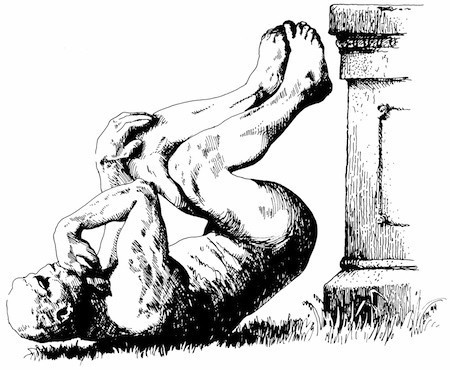Marc Abrahams's Blog, page 338
March 31, 2015
A simple bounce test for lively versus dying batteries
This video shows how a mechanical “bounce test” can reveal how much electrical charge remains in an ordinary alkaline AA battery:
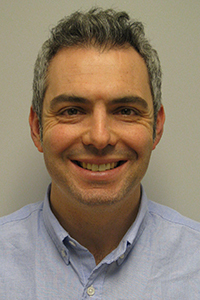 Chemistry World magazine explains: “Inspired by a YouTube video, scientists in the US have confirmed that a simple bounce test can be used as a technique to indicate charge in a battery… A team led by Daniel Steingart [pictured here] of Princeton University have correlated the coefficient of restitution (COR), a measure of bounce, with batteries at various charges and determined their charge to a similar degree of accuracy as in situ energy-dispersive x-ray diffraction (EDXRD).”
Chemistry World magazine explains: “Inspired by a YouTube video, scientists in the US have confirmed that a simple bounce test can be used as a technique to indicate charge in a battery… A team led by Daniel Steingart [pictured here] of Princeton University have correlated the coefficient of restitution (COR), a measure of bounce, with batteries at various charges and determined their charge to a similar degree of accuracy as in situ energy-dispersive x-ray diffraction (EDXRD).”
Steingart’s team published a study in which they explain the details.
March 30, 2015
Professor Flegr interviewed on Swedish radio
Jaroslav Flegr was interviewed on Sveriges Radio today, while he was in Stockholm on the final day of the Ig Nobel EuroTour. The subject: toxoplasma and cats and humans, and about Professor Flegr’s Ig Nobel Prize. The interview is mostly in English.
The 2014 Ig Nobel Prize for medicine was awarded to Jaroslav Flegr, Jan Havlíček and Jitka Hanušova-Lindova, and to David Hanauer, Naren Ramakrishnan, and Lisa Seyfried, for investigating whether it is mentally hazardous for a human being to own a cat.
BONUS: A question for Professor Flegr.
Finger mounted insect dissuasion device (new patent)
“During outdoor activities one is often annoyed or distracted by an insect. For example during static outdoor activities such as sun-tanning or reading, a single fly will often persist in annoyance despite repeated attempts to ‘discourage’ the insect. Such an insect persistently fly’s [sic] and lands on one’s arm or leg for example. Conventional fly-swatters are cumbersome and due to hygiene concerns, are not well suited for ‘swatting’ one’s self.”
 Inventor John Richard Daugherty of Flagstaff, Arizona, US, might have found a solution with his newly patented (December 23, 2014) device: Finger mounted insect dissuasion device and method of use.
Inventor John Richard Daugherty of Flagstaff, Arizona, US, might have found a solution with his newly patented (December 23, 2014) device: Finger mounted insect dissuasion device and method of use.
“The present invention is an insect dissuasion device that resembles a miniature fly swatter adapted to be fixed onto an end of a human finger. When a device of the present invention is attached for example onto an index finger, normal activities such as holding a book or a drink container are unimpeded. An insect can be spontaneously discouraged by simply flexing, slowly encroaching upon and then ‘flicking’ the finger and the attached device of the present invention. Due to the small size of the ‘finger fly swatter’ most insects do not react to its presence and are caught off-guard by the rapid flicking motion.”
Note that the device can also be made available with the business-end shaped as : a whip, a ball, a rake, a human hand, a butterfly net, a spike, and, for novice swatters, a target-practice device.
March 29, 2015
Two Ig Nobel shows in Stockholm Monday
The 2015 Ig Nobel EuroTour arrives in Sweden this week after wending its way through the UK, Belgium and Denmark. The tour concludes with two shows in Stockholm. Here are the details:
KAROLINSKA INSTITUTE, Stockholm, Sweden. Lecture hall Gustaf Retzius, at Berzelius väg 3. Monday, March 30, 3:00 pm. Featuring: Marc Abrahams ; Dr. Nakamats (Ig Nobel winner, photographing every meal he has consumed over a period of 43 years); Jaroslav Flegr (Ig Nobel winner, Is it mentally hazardous for a human to own a cat); Sabine Begall and Pascal Malkemper (Ig Nobel winners, Documenting that when dogs defecate and urinate, they prefer to align their body axis with Earth’s north-south geomagnetic field lines); Andrea Rapisarda (Ig Nobel winner, demonstrating mathematically that organizations would become more efficient if they promoted people at random); Gustav Nilsonne (Karolinska neuroscientist, demonstrating the relative difficulty and ease of walking with a cup of coffee and a cup of beer.).
BOULEVARDTEATERN, Stockholm, Sweden. Gotgatan 73, 116 62 Stockholm.Monday, March 30, 6:30 pm. Same people as in the afternoon show.
BONUS: “A Genius’s Last Show” [Dagens Nyheter report, in Swedish]
BONUS: A question for Professor Flegr
8,315,553,613,086,720,000, and the Monster
Who wrote the paper of papers that has the number 8,315,553,613,086,720,000 in its title? John H. Conway.
The 8,315,553,613,086,720,000 paper is:
“A Group of Order 8,315,553,613,086,720,000,” John H. Conway, Bulletin of the London Mathematical Society, 1 (1969): 79-88.
Someone convinced him to sit down and talk about “Life, Death, and The Monster” Here’s video of that:
To many admirers, Conway is above all the creator of life: the Game of Life. Martin Gardner wrote about that achievement: “The game made Conway instantly famous, but it also opened up a whole new field of mathematical research, the field of cellular automata … Because of Life’s analogies with the rise, fall and alterations of a society of living organisms, it belongs to a growing class of what are called “simulation games” (games that resemble real life processes).”
Here’s Conway doing an informal, long talk about that, and this and that (beginning with sphere packing in 24-dimensional space, and then meandering around various topics):
March 28, 2015
First Rule of Ant Fight Club: Choose a Model for Ant Fight Club
Two ants enter; one ant leaves. (Well, the numbers are actually somewhat larger than that.)
In the paper Modeling ant battles by means of a diffusion-limited Gillespie algorithm, biologist Giacomo Santini and his coauthors have proposed two modeling approaches for studying battles among ants.
When developing theories (for animal behavior and in other complex systems), a crucial scientific step — in addition to experiments and observations, of course — is to develop and analyze one or more models.
Indeed, scientists often pit models against each other. As Santini and coauthors write,
(…) This work is mainly motivated by the need to have realistic models to predict the interaction dynamics of invasive species. The two considered species exhibit different fighting strategies. In order to describe the observed battle dynamics, we start by building a chemical model considering the ants and the fighting groups (for instance two ants of a species and one of the other one) as a chemical species. From the chemical equations we deduce a system of differential equations, whose parameters are estimated by minimizing the difference between the experimental data and the model output. We model the fluctuations observed in the experiments by means of a standard Gillespie algorithm. In order to better reproduce the observed behavior, we adopt a spatial agent-based model, in which ants not engaged in fighting groups move randomly (diffusion) among compartments, and the Gillespie algorithm is used to model the reactions inside a compartment.
The new paper is a sequel to a prior paper by the same authors. So much for not talking about Fight Club.
Bonus: One of the new paper’s citations is a 2009 preprint called Partial differential equations versus cellular automata for modelling combat, and the longstanding fight between PDE and cellular-automata approaches to modeling (of which that paper is but one tiny battle) rages to this day. If you believe Google Fight, it seems that PDEs win this battle. My fellow Oxford applied mathematicians will no doubt be happy about this result.
March 27, 2015
A question for Professor Flegr
At last night’s Ig Nobel show at the University of Aarhus, a woman in the audience asked Ig Nobel Prize winner Jaroslav Flegr: “Can you prove that you are not a character in the movie ‘Back to the Future’“?
Flegr answered: “No.”
Here is a photo of Professor Flegr taken at the event. He is seated at the right. (Ig Nobel Prize winner Hynek Burda is at the left, and Ig Nobel winner Eigil Reimers in the middle.)
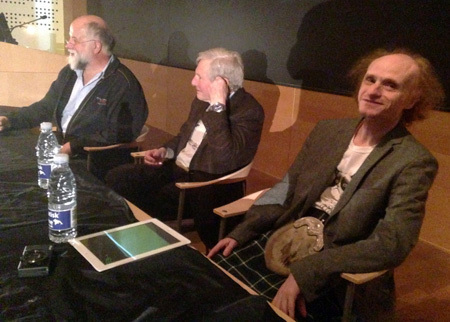
Tonight, the Ig Nobel Tour does a show in Copenhagen. Next Monday, there will be two shows in Stockholm.
Improbable Research weekly podcast, reviewed
Tom Holliman reviewed the Improbable Research weekly podcast. The review appears in the April 2015 issue of The Psychologist:
The Annals of Improbable Research, the magazine dedicated to research that ‘makes people laugh and then think’, has recently launched a weekly podcast, ‘Improbable Research’, which is sure to be a massive hit with anyone interested in the quirky and obscure side of science. Presenter Marc Abrahams’ dead-pan style of reporting is a perfect comedic match for truly improbable research, well suited to discussing papers such as Kees Moeliker’s ‘The first case of homosexual necrophilia in the mallard duck’. However, don’t let this comedy value fool you; ‘Improbable Research’ is a scientific podcast, and the methodology of studies such as Greenway and Garcia’s ‘Designing and testing an improved packaging for large hollow chocolate bunnies’ is treated to rigorous examination, as is an investigation into the economic benefits of Kurt Cobain’s suicide (the tactfully titled paper ‘Artists’ suicides as a public good’), with joyfully entertaining results. ‘Improbable Research’ takes the listener on a hilarious adventure through esoteric, absurd and at times questionable research, and leaves them amused, bemused, and eager for more.
Einstein undergoing fission (a particular philosophical viewpoint)
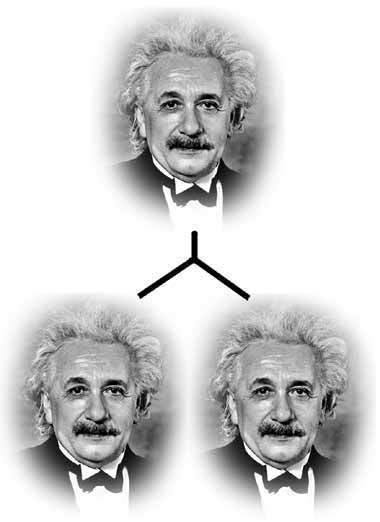 Nobel prize-winning physicist Albert Einstein was of course deeply interested in (and concerned with) the implications of splitting the atom, viz. nuclear fission. Philosophers on the other hand, not only consider such things, but can also go on to wonder : What about splitting Albert himself? Such a scenario is examined by Dr. Wolfgang Schwarz of the Australian National University, who ponders a fissionable Einstein in a recent paper for the journal Mind (October 2014). First he sets the scene with a comparatively straightforward illustration : a train. Specifically one which runs from Berlin to Düsseldorf and Cologne. It reaches a station called Hamm, where it divides in two (one half going on to Düsseldorf the other to Cologne). Should it be called the Düsseldorf train or the Cologne train?
Nobel prize-winning physicist Albert Einstein was of course deeply interested in (and concerned with) the implications of splitting the atom, viz. nuclear fission. Philosophers on the other hand, not only consider such things, but can also go on to wonder : What about splitting Albert himself? Such a scenario is examined by Dr. Wolfgang Schwarz of the Australian National University, who ponders a fissionable Einstein in a recent paper for the journal Mind (October 2014). First he sets the scene with a comparatively straightforward illustration : a train. Specifically one which runs from Berlin to Düsseldorf and Cologne. It reaches a station called Hamm, where it divides in two (one half going on to Düsseldorf the other to Cologne). Should it be called the Düsseldorf train or the Cologne train?
Now, what might happen to Albert?
“What if Einstein had undergone fission or fusion? Suppose Einstein fissioned into two people in 1955. There are then three candidates for the reference of ‘Einstein’: the Y-shaped object that was a person before the fission, and the two branches that were persons after the fission. Which of these does the name pick out? I suppose it would be the Y-shaped object, although we might of course also have a name for one of the branches.”
See: ‘Counterpart theory and the paradox of occasional identity’ Mind (2014) 123 (492): A penultimate draft of which can be read in full here.
Also see: ‘Conceivabilism, inconceivabilism and someone with 200 arms and legs‘
“Neuroscientist honored with Ig Nobel outshines laureates”
The Arizona Daily Star reports:
At UA, neuroscientist honored with Ig Nobel outshines laureates
Neuroscientist Eleanor Maguire seemed surprised when she was introduced Thursday as the most famous member of a panel that included three Nobel-Prize-winning scientists.
Maguire, a professor of cognitive neuroscience at University College London, was awarded an Ig Nobel Prize in 2003 for a study that measured the brain sizes of taxicab drivers during their three-year “knowledge training” required to navigate the 25,000 streets and myriad monuments of central London.
She drew more public attention than the three scientists awarded the Nobel Prize for physiology or medicine in 2014, said Carol Barnes, head of the University of Arizona’s McKnight Brain Institute, who introduced the quartet of neuroscientists to the press before a public talk here.
Maguire’s research, which measured changes in the size and composition of the hippocampus during taxi-driver training, fits in nicely with the work of her Nobel-Prize-winning colleagues, who discovered the “grid” and “place” cells that allow rats to form a mental map.
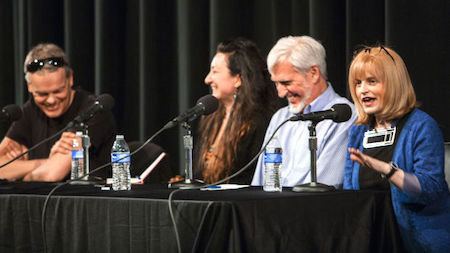
Ig Nobel winner Eleanor Maguire, right, speaks during a forum with students at the University of Arizona. Renowned brain scientists — from left, Edvard Moser, May-Britt Moser, John O’Keefe and Maguire — are visiting the UA campus to speak about their careers. Photo by Ron Medvescek / Arizona Daily Star.
John O’Keefe, professor at the Institute of Cognitive Neuroscience and Department of Anatomy, University College London, located the “place” cells in the tiny, seahorse-shaped hippocampus.
May-Britt Moser and Edvard Moser, both of the University of Oslo, found “grid” cells in the nearby entorhinal cortex….
O’Keefe said the thrill of breakthrough research and the occasional Nobel Prize were not everyday reality. “Most of it is a really hard slog. You have to be good at what you want to do.”
The four scientists were invited by Nadel, Barnes and Mary Peterson, chair of the UA’s School of Mind, Brain and Behavior, to help inaugurate the new multidisciplinary Center for Innovation in Brain Science.
BONUS (kinda-sorta related): Several other Ig Nobel Prize winners are touring Europe, in the 2015 Ig Nobel Euro Tour. Tonight they will do a show at the University of Copenhagen. Monday, they will do two shows in Stockholm, at the Karolinska Institute and then at the Boulevardteatern.
Marc Abrahams's Blog
- Marc Abrahams's profile
- 14 followers


